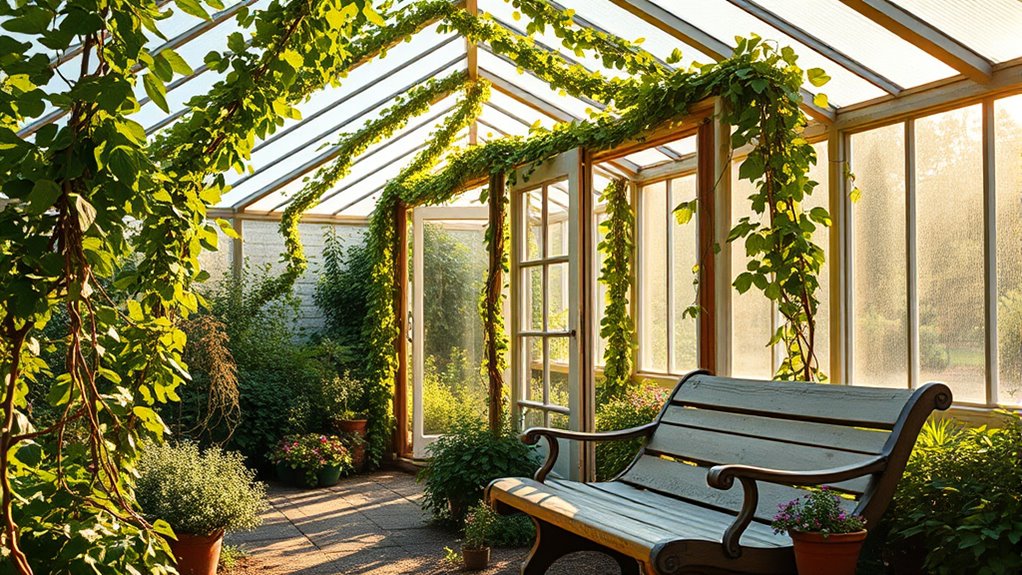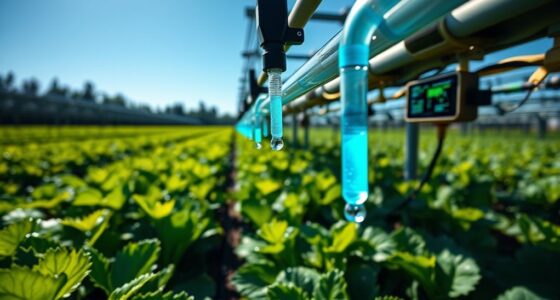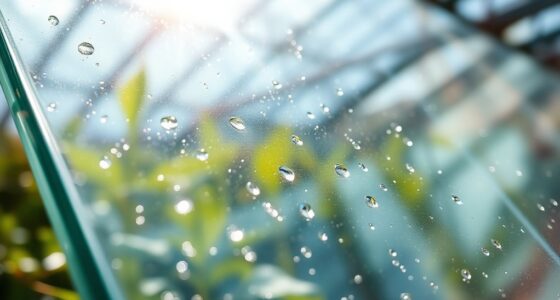When building a greenhouse, consider eco-friendly materials like reclaimed wood, which repurposes resources and lowers your carbon footprint. Bamboo's rapid growth and strength make it an excellent choice, while recycled steel guarantees durability without harming the environment. For glazing, opt for energy-efficient options that enhance light transmission. Implementing smart design choices and sustainable practices can optimize plant growth and reduce waste. Keep going to discover more ways to create your sustainable gardening haven.
Key Takeaways
- Opt for reclaimed wood to reduce waste and enhance structural integrity while minimizing the demand for new lumber.
- Utilize bamboo for its rapid renewability and impressive tensile strength, making it a sustainable choice for construction.
- Incorporate recycled steel to enhance durability and lower carbon emissions while conserving resources compared to virgin steel production.
- Choose energy-efficient glazing options like polycarbonate to improve insulation and promote uniform plant growth within the greenhouse.
- Implement efficient water management practices, such as rainwater harvesting and drip irrigation, to conserve resources and maintain soil health.
Reclaimed Wood: A Sustainable Choice for Structure

When you choose reclaimed wood for your greenhouse structure, you're not just making an aesthetic decision; you're embracing sustainability.
By repurposing materials that would otherwise go to landfills, you greatly reduce waste. Plus, using reclaimed wood lowers your carbon footprint by minimizing the demand for new lumber. This practice supports sustainable forestry while conserving resources and decreasing environmental degradation. Additionally, using older, denser wood increases the structural integrity of your greenhouse, ensuring it withstands the elements effectively. Incorporating natural elements like reclaimed wood not only enhances the greenhouse's aesthetic but also promotes a calming atmosphere for your gardening experience. Furthermore, using reclaimed wood contributes to better digestive health as it supports a balanced ecosystem in your garden. The use of sustainable sourcing practices in selecting reclaimed materials aligns with the growing consumer preference for environmentally friendly options.
Economically, reclaimed wood can be cost-effective, often cheaper than new wood, especially when sourced locally. It can also boost your property value due to its unique charm.
With its durability and moisture resistance, reclaimed wood guarantees your greenhouse stands the test of time, making it a smart, eco-friendly choice for your gardening needs.
The Advantages of Bamboo in Greenhouse Construction

Although many materials can be used in greenhouse construction, bamboo stands out as a superior choice due to its remarkable sustainability and strength. This rapidly renewable resource matures in just three to five years, requiring minimal water and chemicals for cultivation. Plus, bamboo absorbs more carbon dioxide than trees, greatly contributing to climate change mitigation. Its impressive tensile strength rivals that of steel, making it perfect for supporting large structures. Additionally, bamboo's natural fire resistance is ideal for areas prone to natural disasters. With low maintenance needs and cost-effective production, bamboo not only enhances your greenhouse's durability but also helps promote sustainable living. Furthermore, using bamboo aligns with the principles of eco-friendly materials that are essential for modern construction practices. Moreover, bamboo's growth contributes to carbon dioxide absorption, further supporting efforts to combat global warming. Moreover, integrating bamboo with solar technology can further enhance energy efficiency in greenhouse environments.
Utilizing Recycled Steel for Durability and Strength
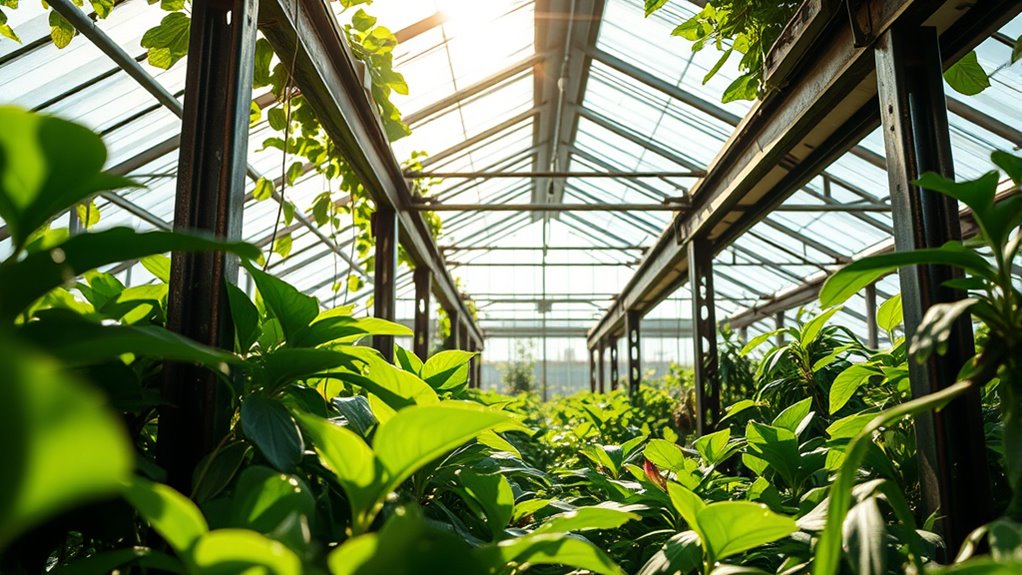
Utilizing recycled steel in greenhouse construction not only enhances durability and strength but also supports a sustainable approach to building. This material retains its robust properties, ensuring your greenhouse withstands harsh weather over time. By choosing recycled steel, you reduce the demand for virgin steel production, conserving valuable resources and minimizing waste. Recycling steel uses considerably less energy, leading to lower carbon emissions and a reduced environmental footprint. Additionally, incorporating recycled steel can be cost-effective, aligning with budget-friendly practices. With its ability to be recycled indefinitely without losing quality, steel becomes a circular resource, contributing to sustainable construction. Ultimately, using recycled steel not only strengthens your greenhouse but also fosters eco-conscious building practices. Furthermore, choosing the right materials is crucial for the overall durability and operational efficiency of the greenhouse. This strategy not only aligns with investment strategies in sustainable building but also promotes long-term environmental benefits. Moreover, using recycled steel contributes to reducing greenhouse gas emissions, which is essential for achieving sustainability goals in construction. Additionally, using gold as an investment can also complement eco-friendly construction efforts by providing a stable financial foundation for future projects.
Innovative Glazing Options for Enhanced Efficiency
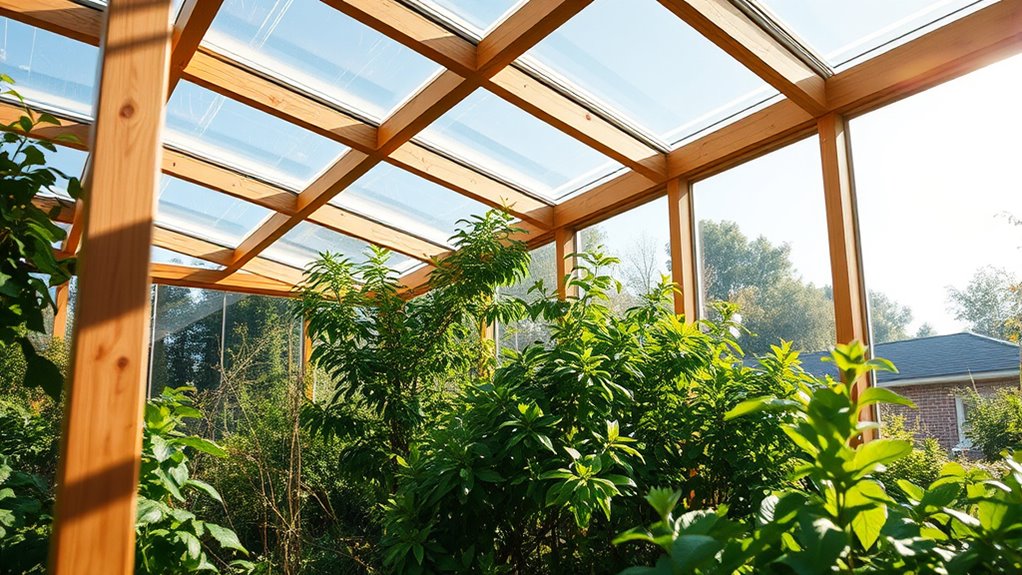
As you explore innovative glazing options for your greenhouse, consider how these materials can greatly enhance energy efficiency and plant growth. Polycarbonate glazing, for example, offers high impact resistance and excellent insulation, helping you preserve heat while reducing energy costs. Look into recycled polycarbonate panels, made from post-consumer plastics, which provide UV protection and durability. Additionally, superior light transmission from polycarbonate promotes uniform plant growth by ensuring that each leaf receives adequate light. Implementing proper sealing methods can further enhance the greenhouse's insulation, reducing energy loss. Furthermore, using energy-efficient heat pumps can maintain optimal temperatures, contributing to a stable growing environment. Incorporating energy-efficient systems can lead to a decrease in overall energy demand, making your greenhouse more sustainable.
You might also find biodegradable plastic panels suitable for specific plants needing lower light. Incorporating low-E coatings and double-glazed panels will regulate temperature, minimizing heat loss.
Advanced light diffusion techniques guarantee uniform light distribution, while smart glazing adapts to changing conditions for peak growth. These eco-friendly options not only support sustainability but also improve your greenhouse's overall efficiency.
Implementing Energy Efficiency Measures in Greenhouses
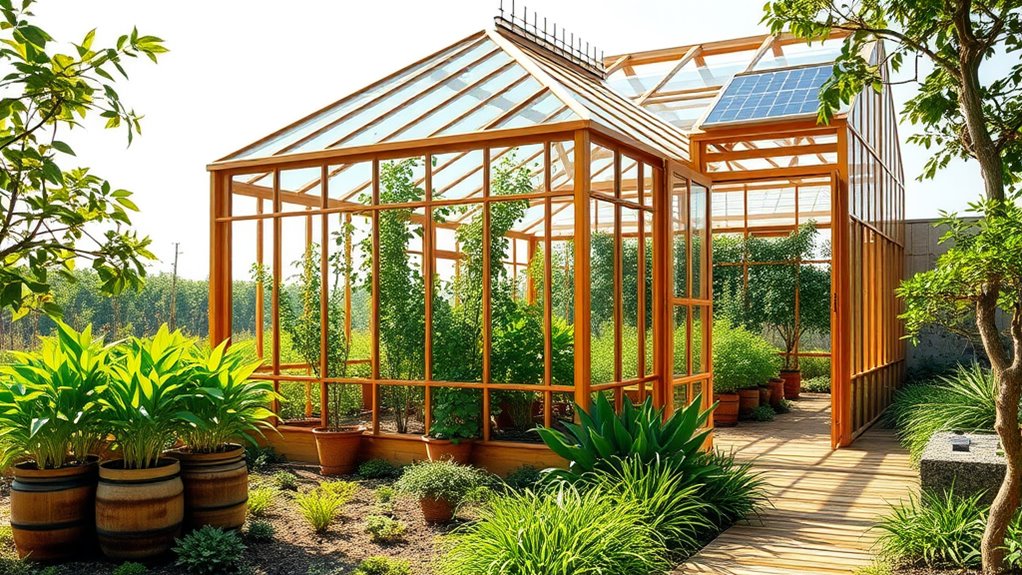
Implementing energy efficiency measures in greenhouses not only lowers operational costs but also supports sustainable practices that benefit the environment. You can start by integrating renewable energy sources like solar panels and wind turbines, which harness natural resources to power your greenhouse. Enhance lighting efficiency with LED bulbs and smart controls to minimize energy consumption. Improve climate control using automated systems and IoT devices to maintain ideal conditions while reducing waste. Focus on greenhouse design by incorporating proper insulation and passive solar techniques to stabilize temperatures. Additionally, consider using geothermal heat pumps as a reliable energy-saving technology that utilizes the Earth's stable temperature for heating and cooling. Furthermore, strategic planning for tax implications can help optimize funding for energy-efficient upgrades. Implementing risk management strategies can also ensure that investments in energy efficiency are protected against unforeseen market fluctuations. Finally, implement energy-saving technologies such as heat pumps and thermal curtains to maximize efficiency. These steps collectively create a more sustainable and cost-effective greenhouse operation, while also contributing to the global fight against climate change.
Sustainable Practices for Optimal Plant Growth
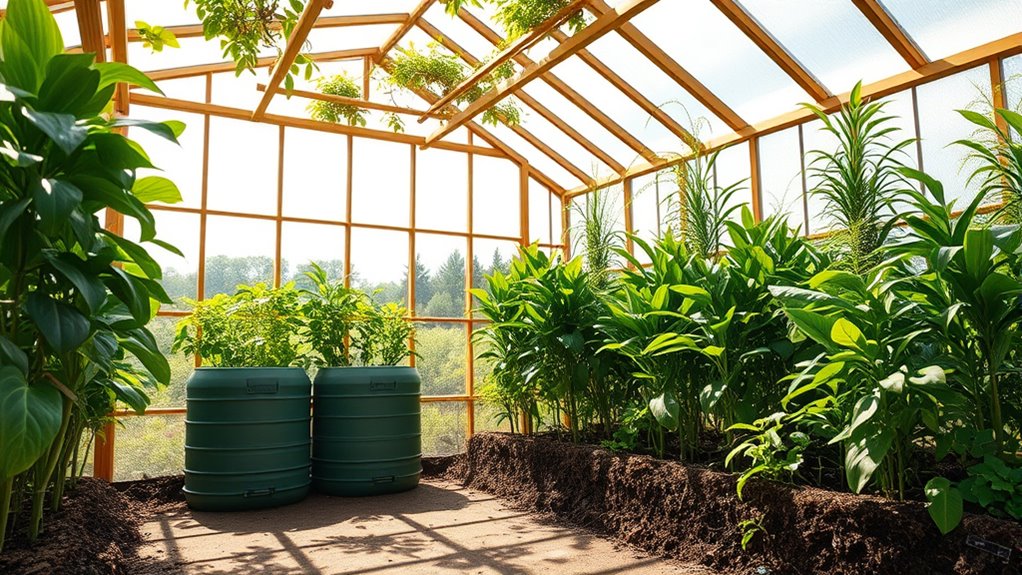
Building on energy efficiency measures, sustainable practices play an essential role in achieving ideal plant growth within greenhouses.
Start by utilizing reclaimed wood or bamboo frameworks for structural integrity; both materials are eco-friendly and enhance aesthetics. Incorporate recycled plastic panels and energy-efficient glazing to maximize light while minimizing heat loss. Additionally, installing solar panels can significantly reduce your greenhouse's carbon footprint and reliance on traditional energy sources. Greenhouses designed with sustainable materials can improve overall performance and longevity. To further enhance energy efficiency, consider using smart shopping techniques to find the best deals on eco-friendly supplies. Implementing natural pest control methods can also reduce the need for harmful chemicals, promoting a healthier environment for your plants.
Efficient water management is critical—implement rainwater harvesting and drip irrigation systems to conserve resources. Position your greenhouse with a north-south orientation for even sunlight distribution, and use reflective surfaces to enhance light exposure.
Embrace sustainable growing practices like composting and crop rotation to maintain soil health.
Finally, consider integrating solar power and LED grow lights to further boost energy efficiency while supporting optimal plant growth.
Reducing Environmental Impact Through Smart Design Choices
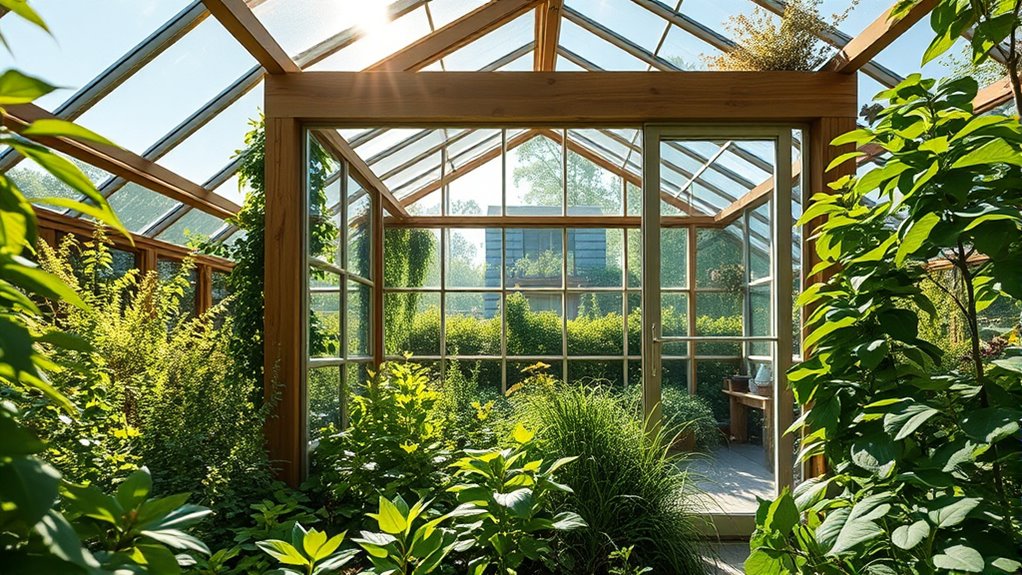
When designing a greenhouse, making smart choices can markedly reduce its environmental impact. Use reclaimed wood to minimize new lumber demand, or opt for recycled plastic panels for durability and insulation. Bamboo frameworks are strong and sustainable, while recycled steel offers versatility. Consider energy-efficient glass to maintain warmth and light. Additionally, using recycled materials for construction can further lower your carbon footprint. Innovative self-watering planters can also enhance your greenhouse's efficiency by reducing the need for frequent watering.
Burning wood emits harmful pollutants, worsening air quality and contributing to climate change, so it's essential to consider these factors in your materials selection. Position your greenhouse for ideal sunlight, reducing additional heating and lighting needs. Implement passive solar design with thermal mass materials to stabilize temperatures. Utilizing sustainable foraging techniques can help you grow a self-sufficient greenhouse ecosystem. Incorporate efficient ventilation systems and consider solar panels for renewable energy. Additionally, incorporate rainwater collection and drip irrigation to conserve water.
Finally, focus on waste reduction by recycling materials and composting plant waste, ensuring a greener approach to your greenhouse project.
Frequently Asked Questions
What Are the Costs Associated With Eco-Friendly Greenhouse Materials?
When you're considering eco-friendly greenhouse materials, costs can vary considerably.
Recycled polycarbonate panels range from moderate to high, while biodegradable plastic panels are more affordable.
Tempered glass tends to be the priciest, offering superior durability and light transmission.
Fiberglass panels fall in the moderate range, balancing cost with longevity.
How Do I Maintain My Eco-Friendly Greenhouse Materials?
To maintain your eco-friendly greenhouse materials, conduct regular inspections for signs of wear and tear, especially after extreme weather.
Clean the structure frequently to promote light transmission and ventilation.
Apply protective coatings to prevent corrosion and UV damage.
Replace materials as needed, following the manufacturer's guidelines.
Guarantee proper drainage to avoid water accumulation and implement organic pest control methods to create a healthy environment for your plants.
Can I Combine Different Sustainable Materials in My Greenhouse?
Absolutely, you can combine different sustainable materials in your greenhouse!
Using reclaimed wood for frames alongside bamboo shelving creates a unique look while reducing waste.
Pairing recycled steel for structural support with polycarbonate panels guarantees durability and excellent insulation.
Experimenting with these materials not only enhances aesthetics but also optimizes your greenhouse's functionality.
Just make certain each material complements the others to achieve the best overall performance and sustainability.
Where Can I Source Sustainable Materials for My Greenhouse?
Think of sourcing sustainable materials like a treasure hunt, where every corner hides a gem waiting for you.
You can explore local salvage yards for reclaimed wood, browse online marketplaces, or check community recycling centers for hidden jewels.
Don't forget to tap into your network; friends and family might've materials to donate.
Also, keep an eye on construction sites—they often have leftover treasures you can salvage for your greenhouse project!
What Certifications Should I Look for in Eco-Friendly Materials?
When you're looking for eco-friendly materials, focus on certifications that guarantee sustainability and safety.
Check for Cradle to Cradle for safe, recyclable products, and look for FSC certification to confirm responsibly sourced wood.
GREENGUARD certification is crucial for low emissions, while LEED can assess broader building sustainability.
Don't forget about the Climate Neutral label, which indicates carbon offset efforts.
These certifications help you make informed, environmentally conscious choices.
Conclusion
Choosing eco-friendly materials for your greenhouse isn't just good for the planet; it can enhance your gardening experience. You might worry that sustainable options lack durability, but materials like reclaimed wood and recycled steel prove otherwise, offering both strength and charm. Imagine a sturdy structure made from beautiful reclaimed wood, with energy-efficient glazing that lets in natural light while keeping your plants cozy. By making smart design choices, you create a thriving environment that's both sustainable and aesthetically pleasing.
